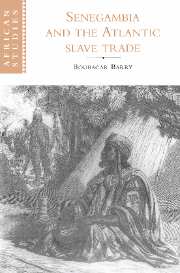Book contents
- Frontmatter
- Contents
- Preface
- Map
- I Senegambia from the fifteenth to the seventeenth century: a haven for incoming populations, a station for migrants on the move
- II Senegambia in the eighteenth century: the slave trade, ceddo regimes and Muslim revolutions
- III Senegambia in the first half of the nineteenth century: legitimate trade and sovereignty disputes
- 9 The crisis of the trans-Atlantic trading system and the triumph of legitimate trade in the first half of the nineteenth century
- 10 Popular rebellions and political and social crises in Futa Jallon
- 11 Futa Jallon expansion into the Southern Rivers region
- 12 The colony of Senegal and political and social crises in northern Senegambia
- 13 Defeat of the holy warriors in northern Senegambia
- IV Senegambia in the second half of the nineteenth century: colonial conquest and resistance movements
- Conclusion
- Notes
- Bibliography
- Index
- Other books in the series
9 - The crisis of the trans-Atlantic trading system and the triumph of legitimate trade in the first half of the nineteenth century
Published online by Cambridge University Press: 31 October 2009
- Frontmatter
- Contents
- Preface
- Map
- I Senegambia from the fifteenth to the seventeenth century: a haven for incoming populations, a station for migrants on the move
- II Senegambia in the eighteenth century: the slave trade, ceddo regimes and Muslim revolutions
- III Senegambia in the first half of the nineteenth century: legitimate trade and sovereignty disputes
- 9 The crisis of the trans-Atlantic trading system and the triumph of legitimate trade in the first half of the nineteenth century
- 10 Popular rebellions and political and social crises in Futa Jallon
- 11 Futa Jallon expansion into the Southern Rivers region
- 12 The colony of Senegal and political and social crises in northern Senegambia
- 13 Defeat of the holy warriors in northern Senegambia
- IV Senegambia in the second half of the nineteenth century: colonial conquest and resistance movements
- Conclusion
- Notes
- Bibliography
- Index
- Other books in the series
Summary
Britain's decision, at the Vienna Congress of 1814, to force all European powers to abolish the slave trade led to profound changes in the trans-Atlantic trading system on the Senegambian coast.
In southern Senegambia, established Euro-African slave-trading families, led by John Ormond and Benjamin Curtis, dominated economic affairs and kept up a contraband slave-trading business until the mid-nineteenth century. However, the parallel development of legitimate trade soon attracted British and French trading companies, especially into Rio Nunez. Once having arrived, they tried to gain control of the Southern Rivers. The economic prosperity of southern Senegambia contrasted sharply with the depressed state of northern Senegambia. There, the failure of colonial plantation schemes led to speculative gum trading from 1830 until peanuts emerged as a miracle crop capable of saving the colony of Senegal.
In both cases peanut farming created the economic conditions France needed to conquer colonial territory, thus pioneering the territorial partition of Senegambia.
Contraband slave trading and legitimate trade in the Southern Rivers region
As in the fifteenth and sixteenth centuries, when Portugal had a trading monopoly there, the Southern Rivers region, compared to northern Senegambia, was an economic zone of capital importance during the entire first half of the nineteenth century. For this region was both a hot-bed of contraband slave trading and the busiest market for legitimate trade, which boomed after the abolition of the slave trade.
- Type
- Chapter
- Information
- Senegambia and the Atlantic Slave Trade , pp. 133 - 147Publisher: Cambridge University PressPrint publication year: 1997



